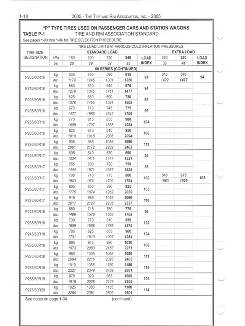There is a lot of contradictory information concerning inflation pressure. But rather than go through it all, allow me to select a single subject and present the other side. It's not that this is the only thing that I could take issue with. It's that this is just one that suits me at the moment:
Quote:
Originally Posted by ShadeTreeMech

......3. tire mfg companies are in bed with petroleum companies because they both rely on the same raw material. So why would a tire company give you a cheap and easy way to cut into their profits as well as the profits of their partners in the petroleum industry?.........
|
This implies that the tire manufacturers are deliberately under-estimating that load carrying capacity vs inflation pressure characteristics.
Here’s a page from the Tire and Rim Association Yearbook that shows the design standard for some passenger car tires:

Here it is full size:
http://www.barrystiretech.com/2005traloadtable.jpg
Notice that the pressure operating range is 26 psi to 35 psi.
Vehicle engineers use this book to select the tire size and the pressure that will carry the load of the vehicle, plus a bit more (good engineering practice). They are required by law to put this information on a sticker on every vehicle they make. This means there are going to be severe consequences when they get this wrong - as the recent Explorer controversy demonstrates.
Tire manufacturers, on the other hand, want to produced the least expensive tire that gets the job done - and since they are designing to the same table......
So it becomes a coincidence, rather than a conspiracy, that passenger car tires will burst at pressures well above the maximum sidewall pressure. There must be something else that causes this - and that something is fatigue.
At this point, I could go into a long discussion about fatigue and how it applies to tires, but I don't want to get too far off Point #3. You can look up fatigue on Wikipedia to see where the discussion would go.